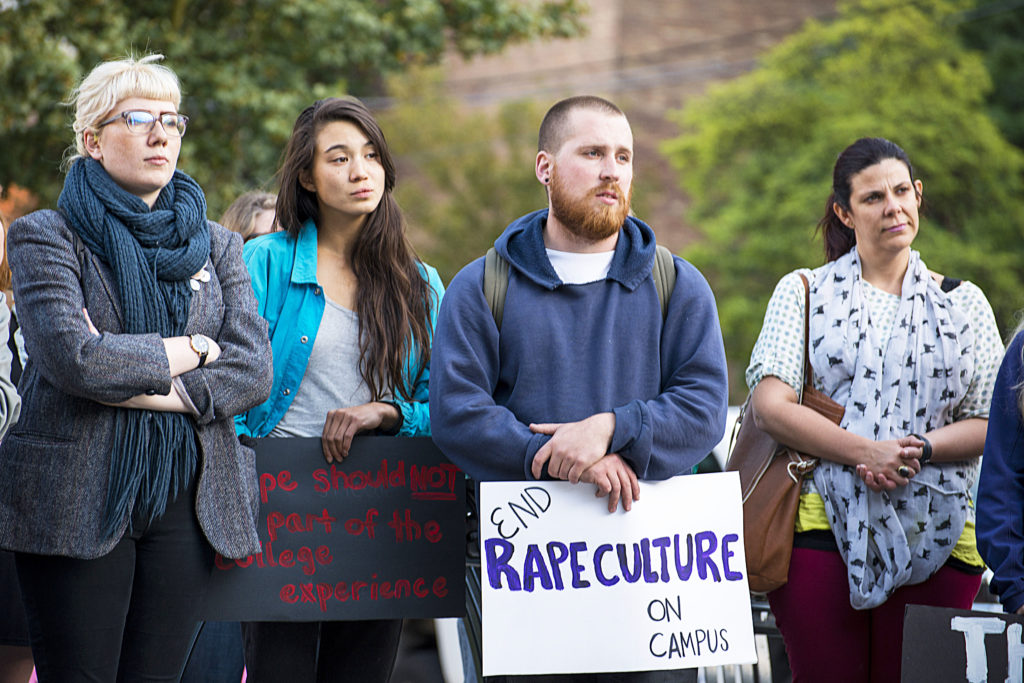What is Rape Culture?
Rape culture is a term that was coined by feminists in the United States in the 1970s. It was designed to show the ways in which society blamed victims of sexual assault and normalized sexual violence.
Many feminists have provided great definitions of what rape culture is and how it plays out every day. Emilie Buchwald, the author of Transforming a Rape Culture, describes that when society normalizes sexualized violence, it accepts and creates rape culture. In her book, she defines rape culture as:
” a complex set of beliefs that encourage male sexual aggression and supports violence against women. It is a society where violence is seen as sexy and sexuality as violent. In a rape culture, women perceive a continuum of threatened violence that ranges from sexual remarks to sexual touching to rape itself. A rape culture condones physical and emotional terrorism against women as the norm . . . In a rape culture both men and women assume that sexual violence is a fact of life, inevitable . . . However . . . much of what we accept as inevitable is in fact the expression of values and attitudes that can change.”

Buchwald’s definition speaks to the experience of women, however, rape culture impacts all marginalized genders, including all trans, nonbinary, and Two-Spirit folks.
The website Force: Upsetting the Rape CuCulture explainsow rape culture is the images, language, laws and other everyday phenomena that we see and hear everyday that validate and perpetuate rape. Rape culture includes jokes, TV, music, advertising, legal jargon, laws, words and imagery, that make violence against women and sexual coercion seem so normal that people believe that rape is inevitable. Rather than viewing the culture of rape as a problem to change, people in a rape culture think about the persistence of rape as “just the way things are.”
Melissa McEwan, the founder of the political and cultural group blog Shakesville, provides an extensive definition of rape culture that answers the questions What does Rape Culture look like and sound like and feel like? It is an excellent definition that provides various examples of Rape Culture, and it can be found here.
Furthermore, WAVAW itself did a comprehensive blog piece on Rape Culture just several months ago, titled “Rape Culture is Real—And Yes, We’ve Had Enough“, which included citing recent current events that exemplified Rape Culture:
“Rape culture is…
…the existence of “Keep Calm and Rape A Lot” t-shirts. They really, seriously exist.
…the media’s constant glossing-over of sexual assault with euphemistic language: “inappropriate behaviour,” “sexual misconduct,” and even plain old “having sex.”
…Facebook’s refusal to pull sadistically graphic images of violence against women (while deeming photos of breastfeeding moms to be objectionable)!
…a beauty website that calls toddlers “effing hot” – even the preschool set can’t escape objectification!
…a magazine editor’s blasé admission that “the women we feature in the magazine are ornamental” and “objectified.”
…major news outlets waxing sympathetic about how two teen rapists’ “promising” lives will be destroyed by a youthful mistake, without once mentioning how the rape might affect the survivor.
…kids who call losing a sports game “getting totally raped.”
…a pizza marketing campaign that makes a joke out of rape.
…a subculture of self-proclaimed “ratters” who hack into women’s computers and steal their photos.
…college women being instructed to vomit or urinate on demand to protect themselves against rape.
…10,000 untested rape kits collecting dust on a shelf somewhere.
We need to notice this stuff, get outraged, and share our outrage with others. Staying aware of rape culture is painful work, but we can’t interrupt the culture of violence unless we are willing to see it for what it is.” – Alana, former WAVAW Coordinator.
- On October 31, 2013

